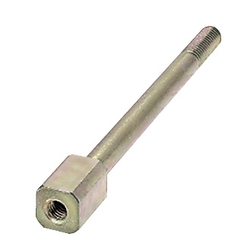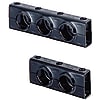(!)NOTE : Windows 7 users won’t be able to use some latest features of eCatalog/WOS since Microsoft is ending support for Windows 7 on 14 Jan, 2020. Please upgrade your system for uninterrupted services.
- Scheduled Maintenance Notice: This site will be unavailable due to scheduled maintenance from 6:30 24/11/2024 to 4:30 (IST) 25/11/2024. We apologize for the inconvenience.
- Please note that the MISUMI Pune office and warehouse will be closed on November 20th due to the state election.
- Notice of End of Sales for Economy Series Pneumatic Equipment Category. More information.
Pipe Clamps(Material:Steel)
Brand |
|
|---|---|
| CAD |
|
| Days to Ship |
|
2 items
- Sort By
-
You can add up to 6 items per a category to the compare list.

MISUMI
[Features]·A black painted multi piping clamp.
- Volume Discount
Main Applicable Pipe O.D.(mm) Material Surface Treatment - Steel Paint From: ₹ 506.48 Days to Ship: Same day or more  Same day or more
Same day or more
-
You can add up to 6 items per a category to the compare list.

Accessories for Plumbing Clamps - Coupling Screws
MISUMI
[Features]·A coupling bolt, a piping clamp accessory.
- Volume Discount
Main Applicable Pipe O.D.(mm) Material Surface Treatment - Steel Chromate Plating From: ₹ 1,198.02 Days to Ship: 6 Day(s) or more  6 Day(s) or more
6 Day(s) or more
| Brand |
|---|
| Product Series |
| CAD |
| From |
| Days to Ship |
| Main Applicable Pipe O.D.(mm) |
| Material |
| Surface Treatment |
You can add up to 6 items per a category to the compare list. | You can add up to 6 items per a category to the compare list. | |
| Brand | MISUMI | MISUMI |
| Product Series | ||
| CAD |
|
|
| From | ₹ 506.48 | ₹ 1,198.02 |
| Days to Ship | Same day or more | 6 Day(s) or more |
| Main Applicable Pipe O.D.(mm) | - | - |
| Material | Steel | Steel |
| Surface Treatment | Paint | Chromate Plating |
Loading...
Related Categories to Pipe Clamps
FAQ Pipe Clamps
- Question: What are the different types of pipe clamps?
- Answer: Common types of pipe clamps include: • Standard Pipe Clamps: Used to secure pipes to walls or ceilings. • U-Bolt Clamps: U-shaped clamps that hold pipes firmly in place. • Split Ring Clamps: These have two halves that fit around the pipe, bolted together for a secure hold. • Cushioned Pipe Clamps: Feature rubber linings to reduce vibration and noise. • Riser Clamps: Support vertical pipe runs. • Hinged Clamps: These can be opened and installed around existing pipework.
- Question: What materials are pipe clamps made of?
- Answer: Pipe clamps are commonly made from materials such as: • Stainless Steel: For corrosion resistance and strength. • Carbon Steel: Strong and cost-effective, often galvanized for rust protection. • Plastic: Lightweight and corrosion-resistant, used in non-structural applications. • Copper: Typically used for plumbing, especially with copper piping.
- Question: What factors should I consider when choosing a pipe clamp?
- Answer: When selecting a pipe clamp, consider the following: • Pipe size: Ensure the clamp is compatible with the diameter of your pipe. • Material: Choose a material that is suitable for the environment and the type of pipe (e.g., stainless steel for corrosive environments, galvanized steel for general use). • Load capacity: The clamp should be able to support the weight of the pipe and any additional loads. • Mounting method: Determine if you need a clamp that can be bolted, welded, or clipped to a surface.
- Question: What are some common pipe clamp maintenance tasks?
- Answer: • Tighten loose bolts: Periodically check the bolts on the clamp and tighten them as needed. • Inspect for corrosion: Look for signs of corrosion, especially in environments with high humidity or exposure to corrosive substances. • Check for damage: Inspect the clamp for any cracks, bends, or other damage. • Replace damaged clamps: If a clamp is damaged, it should be replaced to ensure the safety and integrity of the piping system.
- Question: What is the maximum load a pipe clamp can support?
- Answer: The load capacity of a pipe clamp varies depending on its material, size, and design. Manufacturers typically provide load ratings or specifications, so it’s crucial to refer to these when selecting a clamp for heavy-duty or critical applications.
- Question: Can pipe clamps reduce noise or vibration?
- Answer: Yes, cushioned pipe clamps are designed to reduce vibrations and noise by incorporating rubber or other flexible materials to dampen the movement of the pipe.







How can we improve?
How can we improve?
Thank you for your time.
Your feedback is essential for our continuous improvement
Privacy Policy
Thank you for your cooperation.
Thank you for your time.
Your feedback is essential for our continuous improvement
Please use the inquiry form.
Privacy Policy